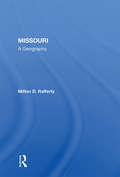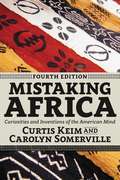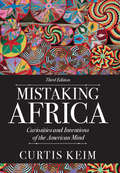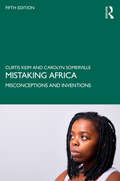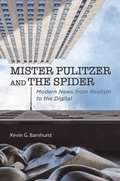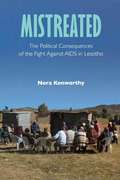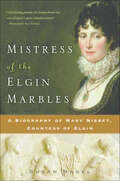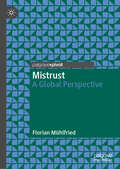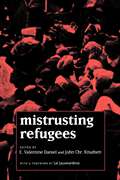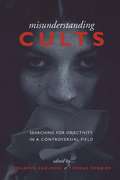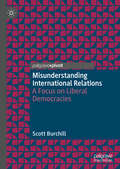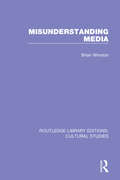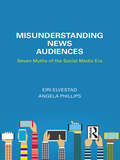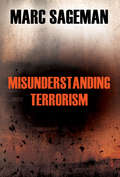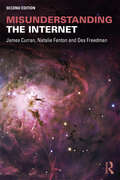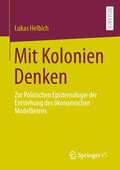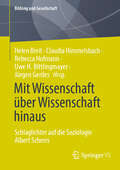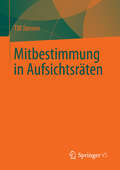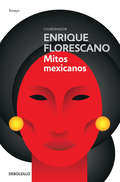- Table View
- List View
Missouri: A Geography
by Milton RaffertyMissouri-from the gateway arch in St. Louis to the Pony Express stables in St. Joseph, from the Ozarks of the south to the rolling, corn-studded hills of the north-is the subject of this comprehensive geography. Dr. Rafferty brings together a wealth of information about Missouri's resources and people, tracing the theme of persistence versus change
Mistaking Africa: Curiosities and Inventions of the American Mind
by Curtis A. Keim Carolyn SomervilleFor many Americans the mention of Africa immediately conjures up images of safaris, ferocious animals, strangely dressed "tribesmen," and impenetrable jungles. Although the occasional newspaper headline mentions authoritarian rule, corruption, genocide, devastating illnesses, or civil war in Africa, the collective American consciousness still carries strong mental images of Africa that are reflected in advertising, movies, amusement parks, cartoons, and many other corners of society. Few think to question these perceptions or how they came to be so deeply lodged in American minds. Mistaking Africa looks at the historical evolution of this mind-set and examines the role that popular media plays in its creation. The authors address the most prevalent myths and preconceptions and demonstrate how these prevent a true understanding of the enormously diverse peoples and cultures of Africa. Updated throughout, the fourth edition covers the entire continent (North and sub-Saharan Africa) and provides new analysis of topics such as social media and the Internet, the Ebola crisis, celebrity aid, and the Arab Spring. Mistaking Africa is an important book for African studies courses and for anyone interested in unraveling American misperceptions about the continent.
Mistaking Africa: Curiosities and Inventions of the American Mind
by Curtis A KeimFor many Americans the mention of Africa immediately conjures up images of safaris, ferocious animals, strangely dressed "tribesmen," and impenetrable jungles. Although the occasional newspaper headline mentions genocide, AIDS, malaria, or civil war in Africa, the collective American consciousness still carries strong mental images of Africa that are reflected in advertising, movies, amusement parks, cartoons, and many other corners of society. Few think to question these perceptions or how they came to be so deeply lodged in American minds. Curtis Keim's Mistaking Africa looks at the historical evolution of this mind-set and examines the role that popular media plays in its creation. Keim addresses the most prevalent myths and preconceptions and demonstrates how these prevent a true understanding of the enormously diverse peoples and cultures of Africa. Updated throughout, the third edition includes a new chapter, "Where Is the Real Africa," discussing the multifaceted nature of the question and the importance of not grasping onto stereotypes of Africa's mythical past. Keim also includes new examples and new images to expand the visual narrative of western views about Africa. Mistaking Africa is an important book for African studies courses and for anyone interested in unraveling American misperceptions about the continent.
Mistaking Africa: Misconceptions and Inventions
by Curtis Keim Carolyn SomervilleFor many in the west, the mention of Africa immediately conjures up images of safaris, ferocious animals, sparsely dressed "tribesmen," and impenetrable jungles. Newspaper headlines rarely touch on Africa, but when they do, they often mention authoritarian rule, corruption, genocide, devastating illnesses, or civil war. Advertising, movies, amusement parks, cartoons, and many other corners of society all convey strong mental images of the continent that together form a collective consciousness. Few think to question these perceptions or how they came to be so deeply lodged in western minds.Mistaking Africa looks at the historical evolution of this mind-set and examines the role that popular media plays in its creation. The authors address the most prevalent myths and preconceptions and demonstrate how these prevent a true understanding of the enormously diverse peoples and cultures of Africa. Updated throughout, the fifth edition considers images of Africa from across the world and provides new analysis of what Africans are doing themselves to rewrite the stories of their continent, particularly through social and digital media.Mistaking Africa is an important book for African studies courses and for anyone interested in unraveling misperceptions about the continent.
Mister Pulitzer and the Spider: Modern News from Realism to the Digital
by Kevin G BarnhurstA spidery network of mobile online media has supposedly changed people, places, time, and their meanings. A prime case is the news. Digital webs seem to have trapped "legacy media," killing off newspapers and journalists' jobs. Did news businesses and careers fall prey to the digital "Spider"? To solve the mystery, Kevin Barnhurst spent thirty years studying news going back to the realism of the 1800s. The usual suspects--technology, business competition, and the pursuit of scoops--are only partly to blame for the fate of news. The main culprit is modernism from the "Mister Pulitzer" era, which transformed news into an ideology called "journalism." News is no longer what audiences or experts imagine. Stories have grown much longer over the past century and now include fewer events, locations, and human beings. Background and context rule instead. News producers adopted modernism to explain the world without recognizing how modernist ideas influence the knowledge they produce. When webs of networked connectivity sparked a resurgence in realist stories, legacy news stuck to big-picture analysis that can alienate audience members accustomed to digital briefs.
Mistreated: The Political Consequences of the Fight against AIDS in Lesotho
by Nora KenworthyAs global health institutions and aid donors expanded HIV treatment throughout Africa, they rapidly "scaled up" programs, projects, and organizations meant to address HIV and AIDS. Yet these efforts did not simply have biological effects: in addition to extending lives and preventing further infections, treatment scale-up initiated remarkable political and social shifts.In Lesotho, which has the world's second highest HIV prevalence, HIV treatment has had unintentional but pervasive political costs, distancing citizens from the government, fostering distrust of health programs, and disrupting the social contract. Based on ethnographic observation between 2008 and 2014, this book chillingly anticipates the political violence and instability that swept through Lesotho in 2014.This book is a recipient of the Norman L. and Roselea J. Goldberg Prize from Vanderbilt University Press for the best book in the area of medicine.
Mistress of the Elgin Marbles: A Biography of Mary Nisbet, Countess of Elgin
by Susan Nagel“A lively and welcome account of a charismatic woman,” drawing on the personal correspondence of Lady Mary Bruce, wife of the Earl of Elgin (People).The remarkable Mary Nisbet was the Countess of Elgin in Romantic-era Scotland and the wife of the seventh Earl of Elgin. When Mary accompanied her husband to diplomatic duty in Turkey, she changed history. She helped bring the smallpox vaccine to the Middle East, struck a seemingly impossible deal with Napoleon, and arranged the removal of famous marbles from the Parthenon. But all of her accomplishments would be overshadowed, however, by her scandalous divorce. Drawing from Mary’s own letters, scholar Susan Nagel tells Mary’s enthralling, inspiring, and suspenseful story in vibrant detail.“Absorbing . . . required reading for anyone interested in cultural history, as well as the art of biography.” —Booklist“A sympathetic and emotionally charged portrait . . . [written] with insight and compassion yet without sentimentality.” —Publishers Weekly“A unique life related with animation, admiration, and affection.” —Kirkus Reviews
Mistrust: A Global Perspective
by Florian MühlfriedThis book examines the social practice of mistrust through the lens of social anthropology. In focusing on the citizens of the Caucasus, a region located at the crossroads of Europe and Asia, Mühlfried counters the postcolonial discourse that routinely treats these individuals, known for their mistrust of the state, as “others.” Combining ethnographic observations presenting mistrust as an observable reality with socio-political issues from a non-Western region, Mühlfried opens up a non-Eurocentric perspective on an underexplored social practice and a major counterpoint to the well-examined social phenomenon of “trust.” This perspective allows for a more profound understanding of pressing issues such as populist movements and post-truth politics.
Mistrusting Refugees
by E. Valentine Daniel John Chr. KnudsenThe twentieth century has seen people displaced on an unprecedented scale and has brought concerns about refugees into sharp focus. There are forty million refugees in the world—1 in 130 inhabitants of this planet. In this first interdisciplinary study of the issue, fifteen scholars from diverse fields focus on the worldwide disruption of "trust" as a sentiment, a concept, and an experience.Contributors provide a rich array of essays that maintain a delicate balance between providing specific details of the refugee experience and exploring corresponding theories of trust and mistrust. Their subjects range widely across the globe, and include Palestinians, Cambodians, Tamils, and Mayan Indians of Guatemala. By examining what individuals experience when removed from their own culture, these essays reflect on individual identity and culture as a whole.
Misunderstanding Cults: Searching for Objectivity in a Controversial Field (The Royal Society of Canada Special Publications)
by Benjamin Zablocki Thomas RobbinsMisunderstanding Cults provides a uniquely balanced contribution to what has become a highly polarized area of study. Working towards a moderate "third path" in the heated debate over new religious movements or cults, this collection includes contributions from both scholars who have been characterized as "anticult" and those characterized as "cult-apologists." The study incorporates multiple viewpoints as well as a variety of theoretical and methodological perspectives, with the stated goal of depolarizing the discussion over alternative religious movements. A prominent section within the book focuses explicitly on the issue of scholarly objectivity and the danger of partisanship in the study of cults. The collection also includes contributions on the controversial and much misunderstood topic of brainwashing, as well as discussions of cult violence, children brought up in unconventional religious movements, and the conflicts between alternative religious movements and their critics. Unique in its breadth, this is the first study of new religious movements to address the main points of controversy within the field while attempting to find a middle ground between opposing camps of scholarship.
Misunderstanding International Relations: A Focus on Liberal Democracies
by Scott BurchillThis book examines the ways in which the study and practice of international relations are misunderstood, both by scholars and politicians. It begins by examining critical errors in reasoning and argument which determine the way key issues in the field are discussed and explained. It then explores a number of case studies which are affected by these errors, including the legal status of the modern nation-state, the Israel-Palestine conflict, the idea of the Deep State, the relationship between the West and radical Islam, the impact of moral righteousness on historical understanding, and the role of class in modern Western politics.
Misunderstanding Media (Routledge Library Editions: Cultural Studies)
by Brian WinstonThe 1980s saw constant reports of an information revolution. This book, first published in 1986, challenges this view. It argues that the information revolution is an illusion, a rhetorical gambit, an expression of profound historical ignorance, and a movement dedicated to purveying misunderstanding and disseminating disinformation. In this historically based attack on the information revolution, Professor Winston takes a had look at the four central information technologies – telephones, television, computers and satellites. He describes how these technologies were created and diffused, showing that instead of revolution we just have ‘business as usual’. He formulates a ‘law’ of the suppression of radical potential – a law which states that new telecommunication technologies are introduced into society only insofar as their disruptive potential is contained. Despite the so-called information revolution, the major institutions of society remain unchanged, and most of us remain in total ignorance of the history of technology.
Misunderstanding News Audiences: Seven Myths of the Social Media Era (Communication and Society)
by Angela Phillips Eiri ElvestadMisunderstanding News Audiences interrogates the prevailing myths around the impact of the Internet and social media on news consumption and democracy. The book draws on a broad range of comparative research into audience engagement with news, across different geographic regions, to provide insight into the experience of news audiences in the twenty-first century. From its inception, it was imagined that the Internet would benignly transform the nature of news media and its consumers. There were predictions that it would, for example, break up news oligarchies, improve plurality and diversity through news personalisation, create genuine social solidarity online, and increase political awareness and participation among citizens. However, this book finds that, while mainstream news media is still the major source of news, the new media environment appears to lead to greater polarisation between news junkies and news avoiders, and to greater political polarisation. The authors also argue that the dominant role of the USA in the field of news audience research has created myths about a global news audience, which obscures the importance of national context as a major explanation for news exposure differences. Misunderstanding News Audiences presents an important analysis of findings from recent audience studies and, in doing so, encourages readers to re-evaluate popular beliefs about the influence of the Internet on news consumption and democracy in the West.
Misunderstanding Terrorism
by Marc SagemanMisunderstanding Terrorism provides a striking reassessment of the scope and nature of the global neo-jihadi threat to the West. The post-9/11 decade experienced the emergence of new forms of political violence and new terrorist actors. More recently, Marc Sageman's understanding of how and why people have adopted fundamentalist ideologies and terrorist methods has evolved.Author of the classic Understanding Terror Networks, Sageman has become only more critical of the U.S. government's approach to the problem. He argues that U.S. society has been transformed for the worse by an extreme overreaction to a limited threat--limited, he insists, despite spectacular recent incidents, which he takes fully into account. Indeed, his discussion of just how limited the threat is marks a major contribution to the discussion and debate over the best way to a measured and much more effective response.
Misunderstanding the Internet (Communication and Society)
by James Curran Des Freedman Natalie FentonThe growth of the internet has been spectacular. There are now more than 3 billion internet users across the globe, some 40 per cent of the world’s population. The internet’s meteoric rise is a phenomenon of enormous significance for the economic, political and social life of contemporary societies. However, much popular and academic writing about the internet continues to take a celebratory view, assuming that the internet’s potential will be realised in essentially positive and transformative ways. This was especially true in the euphoric moment of the mid-1990s, when many commentators wrote about the internet with awe and wonderment. While this moment may be over, its underlying technocentrism – the belief that technology determines outcomes – lingers on and, with it, a failure to understand the internet in its social, economic and political contexts. Misunderstanding the Internet is a short introduction, encompassing the history, sociology, politics and economics of the internet and its impact on society. This expanded and updated second edition is a polemical, sociologically and historically informed guide to the key claims that have been made about the online world. It aims to challenge both popular myths and existing academic orthodoxies that surround the internet.
Mit Haushaltsdisziplin gewinnt man keine Wahlen: Ökonomische Analyse der Reform des öffentlichen Haushalts- und Rechnungswesens
by Matthias KnödlerDas herkömmliche Rechnungswesen der öffentlichen Verwaltung ist die Kameralistik. Diese ist den gestiegenen Anforderungen aus Sicht von Wissenschaft und Praxis nicht mehr gewachsen und wird in Teilen der öffentlichen Hand seit nunmehr zwei Jahrzehnten durch die Doppelte Buchführung (Doppik) abgelöst. Das vorliegende Buch untersucht die Wirkungen dieser Reform auf das Handeln der betroffenen Akteure.Es wird der Frage nachgegangen, ob und gegebenenfalls unter welchen institutionellen Bedingungen das doppische Haushalts- und Rechnungswesen bzw. die darin integriertenInstrumente im kommunalen und staatlichen Bereich den mit der Einführung verbundenen Erwartungen gerecht werden kann. Untersucht werden deshalb die Fragen nach effizienzfeindlichen Institutionen der Finanzsteuerung und deren konzeptioneller Berücksichtigung in der Doppik. Dabei werden die Grenzen der Reform, aber auch die organisationsbezogenen Effizienzpotenziale der Einführung von dezentraler Budgetierung, Zielvereinbarungen und einem auf Quasiwettbewerb beruhenden Controllings theoretisch fundiert nachgewiesen und Lösungsvorschläge abgeleitet.
Mit Kolonien Denken: Zur Politischen Epistemologie der Entstehung des ökonomischen Modellierens
by Lukas HelbichDiese Arbeit analysiert Entstehungspunkte des ökonomischen Modellierens in kolonialen Kontexten zwischen dem frühen 18. und 19. Jahrhundert. In drei Fallstudien rekonstruiert Lukas Helbich die offenkundigen und weniger offensichtlichen Spuren des Kolonialismus in den Verfahren, Formen und Inhalten ökonomischen Modellierens avant la lettre. Ökonomisches Modellieren wurde im kolonialen Kontext eingeübt und erprobt, Kolonien fungierten für die untersuchten Autoren Richard Cantillon, Victor Riquetti de Mirabeau und Thomas Robert Malthus als Proto-Modelle des ökonomischen Modellierens.
Mit Wissenschaft über Wissenschaft hinaus: Schlaglichter auf die Soziologie Albert Scherrs (Bildung und Gesellschaft)
by Jürgen Gerdes Uwe H. Bittlingmayer Helen Breit Claudia Himmelsbach Rebecca HofmannDer Sammelband verfolgt ein allgemeines und ein spezifisches Ziel. Das allgemeine Ziel besteht in der Auseinandersetzung mit unterschiedlichen Fragen der Ungleichheitssoziologie, wie sie u.a. in der sozialwissenschaftlichen Diskriminierungsforschung, der Fluchtforschung, der Soziologie Sozialer Arbeit verhandelt werden. Diese Auseinandersetzung wird gerahmt einerseits durch gesellschaftstheoretische Beiträge etwa zu den Forschungsfeldern Sozialisation oder Ethnizität gerahmt und andererseits wird der Bogen gespannt in eine unmittelbar öffentliche Soziologie gespannt, die das Motto Adornos "Eingriffe" aktualisiert. Das spezifische Ziel des Bandes ist die Auseinandersetzung mit dem umfangreichen Werk von Albert Scherr, dem dieses Buch gewidmet ist. Kapitel &“Employer discrimination in Bulgaria: How organizational context shapes ethnic preferences&” ist unter einer Creative Commons Attribution 4.0 International License über link.springer.com frei verfügbar (Open Access).
Mit dem Leben Schritt halten: Eine Analyse des Wearable-Dispositivs (Medienbildung und Gesellschaft #51)
by Franziska Margarete Schloots„Lerne deinen Körper besser kennen“, „Das Beste für deine Gesundheit“ und „Ihre Transformation beginnt jetzt“ - mit Versprechen wie diesen vermitteln die Produkttexte von Wearables wie Fitnesstracker und Smartwatches ein ganz bestimmtes Bild ihrer vorgesehenen Nutzer*innen und deren Nutzung. Verbunden mit den kleinen, am Handgelenk getragenen Geräten sind Fragen nach Erkenntnisgewinn und Kontrollverlust, Selbstoptimierung und Quantifizierungslogiken, Eigenverantwortung und Fremdsteuerung. Die vorliegende Arbeit widmet sich diesem komplexen Spannungsfeld und verfolgt dabei einen multiperspektivischen Ansatz: im Rahmen einer Dispositivanalyse werden die einzelnen Elemente des Wearable-Dispositivs als eigenständige, empirisch zu untersuchende Analysegegenstände betrachtet, um so das Zusammenwirken und die komplexe Beziehung von Diskursen, Gegenständen, Nutzung, Subjekten und Gesellschaft zu erforschen. Ein besonderes Erkenntnisinteresse liegt dabei auf dem Wissen, was sich über Wearables etabliert hat und sich in den Alltagspraktiken der Nutzer*innen widerspiegelt sowie bei der Frage nach den möglichen Funktionen und Auswirkungen des Wearable-Dispositivs.
Mitarbeiterzeitschriften und das interne Web 2.0: Eine empirische Vergleichsstudie zu gedruckten Mitarbeiterpublikationen
by Christian CauersKommunikationsabteilungen in Unternehmen stehen aktuell unter starkem Veränderungsdruck: So sind Erwartungshaltungen an die interne und externe Kommunikation aufgrund der Digitalisierung bei Entscheidern und Belegschaft im Unternehmen sowie von anderen Anspruchs- und Konsumentengruppen gestiegen. Die digitale Beschleunigung des Informationstransports, „rund-um-die-Uhr“-Verfügbarkeiten von Kommunikations- bzw. IT-Angeboten, der immer kürzer werdende Zyklus von technischen Neuerungen, ein „Informationswettbewerb“ diverser Angebote und vieles mehr, führen dazu, dass innerbetriebliche Kommunikationsangebote bezüglich Effizienz, Effektivität und wirtschaftlichem Erfolgsbeitrag auf dem Prüfstand stehen. Ausgehend von der gedruckten Mitarbeiterzeitschrift als klassischem, erfolgreichem Traditionsmedium vieler Betriebe wird in dieser Arbeit über einen Vergleich zweier repräsentativen Studien untersucht, ob und wie sich das Medium – angesichts der digitalen Herausforderungen – formal, inhaltlich und organisatorisch über zwölf Jahre hinweg verändert hat. Zusammenfassend lässt sich ausmachen, dass die „gedruckte Mitarbeiterpublikation“, wenn sie strategisch und inhaltlich sinnvoll zum Unternehmen und den Kommunikationsbedürfnissen der Belegschaft passt, immer noch ein starkes Kommunikations- und Dialogmedium sein kann.
Mitbestimmung in Aufsichtsräten
by Till JansenDie Unternehmensmitbestimmung wird immer wieder in Politik und Öffentlichkeit diskutiert. Dennoch ist wenig über die Praxis der mitbestimmten Aufsichtsratsarbeit bekannt. Die vorliegende Studie greift auf knapp 180 Interviews mit Aufsichtsräten großer deutscher Unternehmen zurück und nähert sich der gelebten Aufsichtsratspraxis. Es wird analysiert, wie Arbeitnehmer- und Anteilseignerinteresse konstruiert werden und welche Formen der Zusammenarbeit zu beobachten sind. Dabei entfaltet sich eine Typologie von vier Umgangsformen, die unerwartete Blicke in die Aufsichtsratsarbeit gewährt.
Mitford's Japan: Memories and Recollections, 1866-1906 (Japan Library Classic Paperbacks Ser.)
by Hugh CortazziAs the preface to this new edition points out, Mitford (Algernon Bertram, the first Lord Redesdale) was a gifted writer whose descriptions of Japan, during the critical time of transition from a feudal to a modern state in the late nineteenth century, are a testimony to his narrative skills, accuracy and objective reporting - qualities which are sometimes overshadowed by the higher profile given to his contemporary Ernest Satow. Accordingly, this new paperback edition, which makes the Mitford memoirs available to a much wider audience, includes a wide selection of extracts from Mitford's bestselling Tales of Old Japan (1871) - what Mitford, according to Carmen Blacker, perceived as the essence of the Japanese spirit: 'heroic, ruthless, devotedly loyal, bloody and chivalrous'.
Mitos mexicanos (nueva edición)
by Enrique FlorescanoEn Mitos mexicanos, una compilación coordinada por Enrique Florescano, varios reconocidos estudiosos y escritores se reúnen para analizar tanto los mitos fundacionales del país, como las figuras actuales que han alcanzado un lugar privilegiado en el imaginario colectivo mexicano.El mito es una de las expresiones de la mentalidad colectiva. Manifiesta las aspiraciones más recónditas de los seres humanos, y transmite, por ejemplo, temores compartidos o construye seres legendarios, héroes o villanos, y los convierte en personajes mitológicos.En Mitos mexicanos, estudiosos y escritores como Carlos Monsiváis, José Woldenberg, Juan Villoro, Margo Glantz, Hugo Hiriart, Carlos Montemayor, Cristina Pacheco, Bárbara Jacobs y Soledad Loaeza, entre otros, se reúnen para conformar un inventario de los mitos más entrañables u obsesivos para los mexicanos. Dividido en tres partes, el libro abarca desde los mitos fundacionales del país, hasta aquellos con los que convivimos hoy en día. También analiza figuras actuales que han alcanzado un lugar privilegiado en el imaginario colectivo, como el mariachi, el guerrillero, el narcotraficante, el rockero, el chicano y otros ídolos de reciente creación.La crítica ha dicho:"La obra de Enrique Florescano es una de las más sólidas en el ámbito de las ciencias sociales en México. Se trata de un trabajo sistemático de exploración del pasado que ha permitido comprender mejor la sociedad mexicana actual y sus perspectivas." -Andrés Fábregas Puig¸ Nexos-
Mittelschicht unter Druck: Dynamiken in der österreichischen Mitte
by Roland Verwiebe Laura WiesböckIn Europa schrumpft die Mittelschicht, was für eine Reihe von EU-Mitgliedsländern bislang kaum untersucht wurde. Dies trifft auch auf Österreich zu, welches sich durch Umbau der Sozialpolitik, Flexibilisierung des Arbeitsmarktes, Zuwanderung und einem Aufstieg rechter politischer Parteien in einem starken Umbruchprozess befindet. Dies ist der Hintergrund für eine in diesem Sammelband erstmalig vorgenommene Analyse des Schrumpfens der österreichischen Mittelschicht. Der Band ist multidisziplinär angelegt (Autor*innen aus Soziologie, Ökonomie, Politikwissenschaft, Zeitgeschichte), und versammelt theoretisch orientierte und empirische Beiträge etablierter Autor*innen wie auch Nachwuchswissenschaftler*innen.
